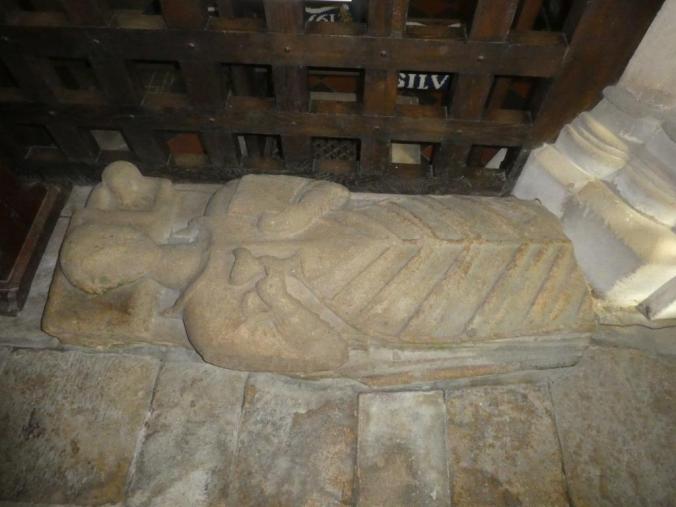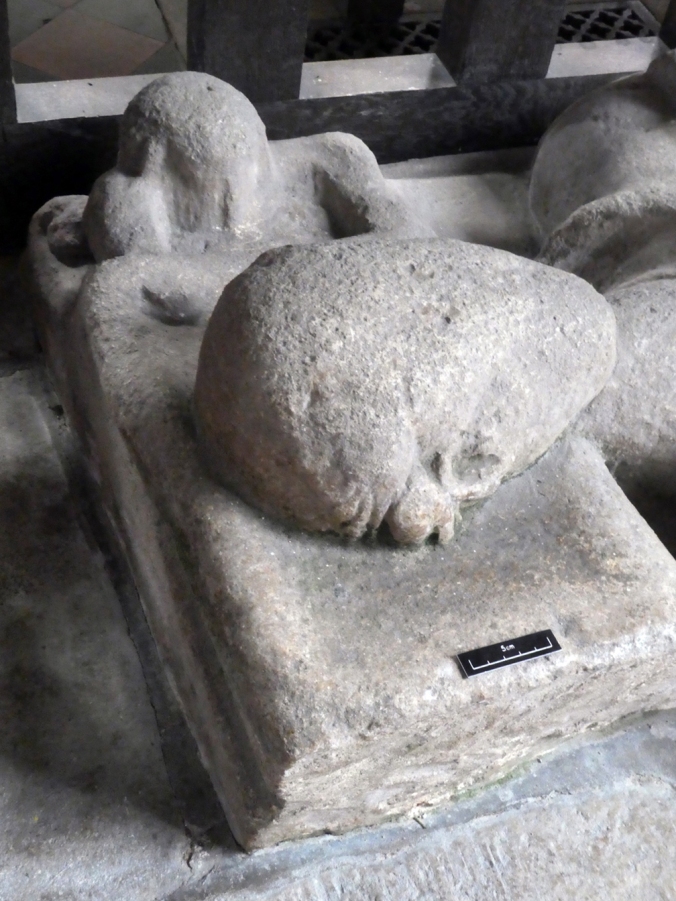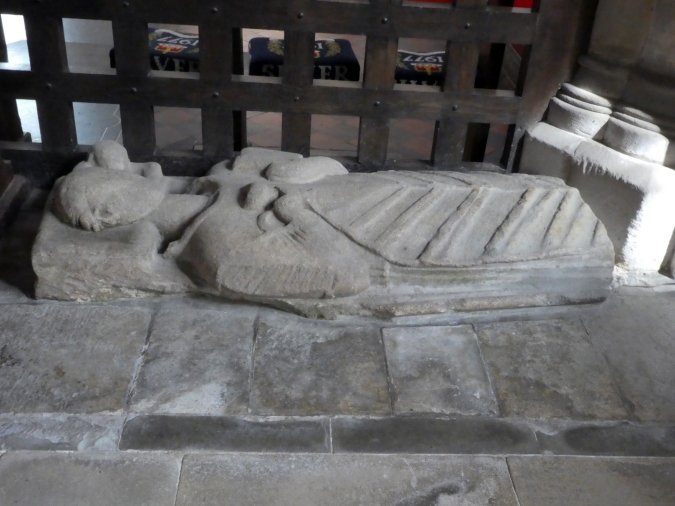Not a Welsh tomb – but a tomb, and a lovely example of the way that folk traditions can develop around tomb carvings (crossed legs and Crusaders, ‘pirate’ tombs with skulls and crossbones, effigies of ‘giants’ …)
I’ve been working with Howard Williams on a carved slab which has turned up in Llangollen and which very probably depicts a c 1300 abbot of Valle Crucis (see https://howardwilliamsblog.wordpress.com/2016/10/21/smiling-abbot-part-3/ and the links from that). He seems to be shown carrying a book (quite common for priestly effigies) and something we can only identify as a paten.
So I was very excited when an old colleague sent me a link to this http://geddingtonchurch.org.uk/the-shrine-of-hagius/ with a photograph of another priest. The wonderful @Stiffleaf has a better photo of it at http://www.ipernity.com/doc/stiffleaf/44753570/in/keyword/4985488/self and the priest is clearly carrying a paten. He has the chalice in his right hand and a book in his left, so the paten is tucked rather awkwardly under his right arm. There’s also a suggestion of something hanging from his right wrist – it could be a maniple, though that would normally be on the left. He is vested for Mass, with a chasuble over his alb. The folds of the chasuble have muddled many attempts to describe the effigy. The Northamptonshire Pevsner says he is covered by a shield, and Bailey’s Northamptonshire in the Early Eighteenth Century: the drawings of Peter Tillemans and others describes it as a semi-effigy withy the lower part of the body covered. The effigy is badly worn, especially around the face and hands, though oddly the chasuble is still quite clearly carved.

The Geddington priest: photo (c) Norman Hammond
So far, so good: a standard early C14 effigy of a priest, with the interesting (though not unique) feature that he is carrying a paten as well as chalice and book. Brian and Moira Gittos have sent me references to similar effigies at Barnard’s Castle and Ledbury. There is also a cross slab at Sproatley with chalice and paten touched by a disembodied hand. All this is very helpful in our efforts to elucidate the Llangollen stone.
I was more concerned, though, by some of the other material on the web site. It gives him the name Hagius, which it says is recorded on an inscription on the effigy (now said to be below floor level and invisible) and in a document in the archives of the nearby Boughton Castle. The web site further claims that Hagius ‘died whilst celebrating the Eucharist. This is often considered as a significant and saintly way for God to call a person home to Him, and so it is not wonder that Hagius quickly became considered locally as a saintly individual … In this effigy, Hagius’ priestly credentials are evidenced by the chalice, paten and bible which are placed lovingly in his hands. His saintly credentials evidenced by his long neck and tonsure – signs of devout holiness.’
The idea that this was a priest who died while celebrating the Eucharist seems to be a local tradition invented to explain the chalice and vestments. The eighteenth-century antiquarian Bridges mentions the tradition in his History of Northamptonshire only to dismiss it. Apart from anything else, there are far too many priestly effigies with chalices – they can’t all have died at the altar. In fact, the only record of one that I could find was an anti-Wyclif text by Thomas Gascoigne who says Wycliffe had a stroke at the elevation and implies it was a divine punishment for his errors about the Eucharist. (I owe this one to Thomas Izbicki on the medieval-religion jiscmail group: he says see Andrew Larsen’s article in A Companion to John Wyclif (2006).) There are plenty of texts telling you how to cope if a priest dies while celebrating – at what point you take over, what you do if the bread or wine is spilled – but nothing on the fate of his soul. There is also a well-evidenced medieval belief that if you died while watching Mass you would go straight to Heaven – that one is in the Lay Folks’ Mass Book and its Welsh equivalent, ‘Rhinweddau Gwrando Offeren’ (for a Welsh article on that see https://cylchgronau.llyfrgell.cymru/view/1229967/1233814/35#?xywh=-673%2C1388%2C4153%2C2054 – thanks to Ann Parry Owen for those references). But again nothing about exceptional holiness.
The tonsure and the long neck, too, proved misleading. The tonsure simply shows he was a priest. The long neck was the style of the early fourteenth century: nothing to do with holiness.
That made me wonder about some of the other material on the web site. There is a little bit of late Saxon stonework in the fabric of the church. The web site says ‘Bones from a Saxon grave were discovered while the floor was being repaired in 1990, and it is thought that these were most likely from a Saxon priest/monk who will have served this church dutifully over 1000 years ago.’ I contacted the county archaeologist. She sent me a brief report of the 1990 excavation from South Midlands Archaeology for 1991. That said there was ‘a burial oriented east-west and located at the south-east corner of the easternmost pillar base [of the south aisle] – though no relationship could be determined. About half of the oval grave was uncovered, including the head and top left side of the body. Three limestone fragments supported the skull. The grave was a minimum of 0.14m. deep and vertically sided. No datable finds were found in its fill.’
In Requiem: the medieval monastic cemetery in Britain, Gilchrist and Sloane say stones as head supports (with and without coffins) are found across southern and western England and from C11-C16 but are more common in C11 and C12 (this is on pp 137-8 of Requiem). This burial is presumably the one referred to as ‘Saxon’ in the church web site. It could be very late Saxon but is possibly later. Traditionally, alignment with the head to the east was held to denote a priest. The idea was that at the Day of Judgement, when we would all rise out of our graves, the priest would rise facing his people and would be able to guide them. There is nothing in the grave, though, to suggest it was that of a priest. Depending on the date, it was probably someone of importance, but burial in church became increasingly common in the later middle ages.
The web site goes on to say ‘The shrine of Hagius would have been a place of significant pilgrimage for centuries, as the Holy Water stoup to the left of the priest’s head signifies’.

The head of the effigy and the ‘stoup’: photo (c) Norman Hammond
Holy water stoup? None of my contacts in the Church Monument Society had ever seen a stoup as part of an effigy. They all thought it much more likely that the very worn feature to the left of the priest’s head was an angel supporting his pillow. The whole slab with the effigy on it was clearly wedge-shaped at one time and it has been trimmed down, possibly for use in building.

Damage to the side of the effigy and slab: photo (c) Norman Hammond
There was probably another angel to the right of the priest’s head. A rough sketch of the monument by the Dutch artist Peter Tillemans in 1719 shows the surviving angel quite clearly. (The drawing is in British Library Additional MS 32467, no. 106, and it’s reproduced in Bailey’s Northamptonshire in the Early Eighteenth Century.) There is another drawing by Sir Henry Dryden in 1843 in the Northampton Central Library (https://vads.ac.uk/large.php?uid=30721&sos=0). That shows features on the effigy; the supporting angel is much less detailed but the hands on the pillow are quite clear.
The effigy is now in the lady chapel but it may have been moved at least once. The church web site points to an illustration in Bridges, but this is clearly a confusion with the Tillemans sketch. The note on the back of the sketch says the effigy is ‘In the N Isle at ye upper end under the N. wall’, but Bridges says it is adjacent to an inscription at the upper end of the south chancel. According to Bailey, the note on the back of the sketch is not in Tillemans’ hand and may be inaccurate.
And what about the inscription: Hagius ecclesiae capellanus, Hagius, priest of the church. The only record of that was in the document in the published edition of the Boughton Castle archive. This was an unsigned letter to Charles Lamotte, rector of Warkton, in about 1736. Lamotte had worked as steward for the 2nd Duke of Montagu, owner of Boughton, and seems to have passed the letter on to him. None of the antiquarians who visited the church seemed to have noticed the writing on the effigy. They made various attempts at transcribing the inscriptions in Lombardic capitals recording the priests who contributed to the rebuilding of the chancel. These inscriptions once formed the chancel steps and are now rearranged around the chancel. Bridges didn’t seem to have noticed anything on the tomb: but in what he said about the effigy there was a cross-reference to an earlier part of the book. I followed that up and found that, under the nearby parish of Lamport, he described a burial with a key and a candlestick which he thought was an acolyte. Then he compared it with effigies of priests like the one at Geddington, with the inscription ‘Hujus ecclesiae capellanus’.Not Hagius but Hujus – ‘ priest of this church’.
Much of the ‘letter’ in the Boughton archive was actually copied out of Bridges, including the bit about the candlestick and the acolyte. Clearly, it couldn’t have been copied from the printed book. Bridges died in 1724 but the book wasn’t published until 1791. So it must have been done by someone who had access to his notes and drafts. And looking at the original document in the Boughton Castle archives, it’s clear that that too says not ‘hagius’ but ‘hujus’, It was a simple mistranscription by someone unfamiliar with medieval Latin.
So what we can say is that we have in Geddington the effigy of a priest, but that we do not know his name. He probably was a person of local repute: he was buried in the church, at a date when that was still an unusual privilege, with an elaborate tomb when most people went to the grave with only a shroud. But that is all.
There are still problems. Who copied the material from Bridges’ MSS and sent it to Lamotte? If there was ever an inscription, where was it? Jean Wilson of the Church Monuments Society has examined the effigy slab carefully and thinks it is all still visible. There is now no trace of any inscription. The lower part of the effigy is missing, as well as the angel to the right of the priest’s head. Tillemans’ drawing has only one angel. It does look as though the lower part of the slab is still there, but to be honest the drawing is so sketchy that it’s difficult to be sure. The lower part had clearly gone by the time Dryden drew the carving in 1843. So was the inscription there, or is it a confusion with an inscription elsewhere? The fact that Bridges does not mention it in the chapter on Geddington does suggest that there is something dubious about it. More work on the MSS may elucidate this as well.
And how can we explain the wear on the face and hands of the effigy, and the difference between the upper part of the body and the chasuble? Bridges said the effigy was at the upper end of the south chancel. The chancel was virtually derelict in the early nineteenth century and it is possible that the upper part of the effigy was exposed to water dripping from the roof but that the lower part was protected in some way. Alternatively, it is possible that a local cult had developed around the effigy, based on the tradition that he was carrying the vessels for Mass because of his exceptional holiness. There are plenty of other examples of post-Reformation cults forming around gravestones and effigies. The effigy of a C13 bishop in Llandaff Cathedral was believed to be that of St Teilo, founder saint of the cathedral, and his tomb was in the C18 a place for striking business deals. There is considerable hand wear around the feet of the effigy, which people touched to seal the agreement. The incised effigial slab of a local couple on the parish church of Christchurch near Newport in Gwent was widely believed to have healing powers and people laid their children on it in the hope of a cure. As a result, it has been almost completely worn away. However, hand wear does look different from weathering. It depends to some extent on the stone type, and it would need close examination, but from photographs the wear on the Geddington effigy looks more like weathering.
The sad thing is that there is of course a very interesting story at Geddington. It just isn’t the story that is on the church web site. What we have is, if you like, the Grave of the Unknown Priest. He may have been one of the men who organised the building work in the church, or he may have been another whose name is known only to God. He served the parish, out in all weathers baptising sickly babies and taking the last rites to dying parishioners. His was not the heroism of sanctity but the day-to-day heroism of a man doing his job. He said the prayers in church, even when there was no-one else to say them with him. Because of his ministry, and that of people like him, the church is still a place where prayer has been valid.
But his name wasn’t Hagius.